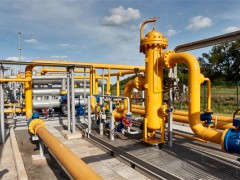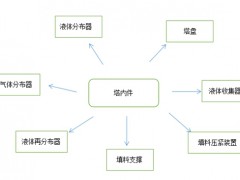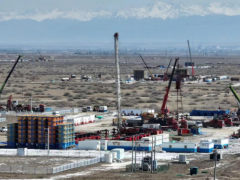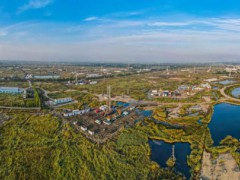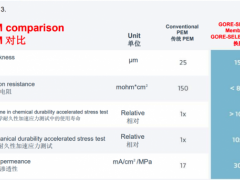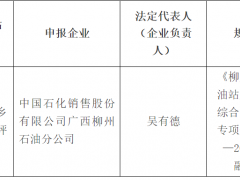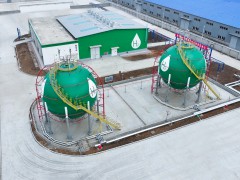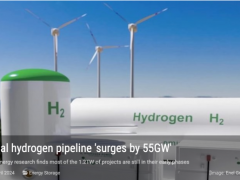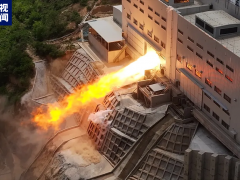美国能源信息署(EIA)预测,今年美国的石油总产量将达到1261万桶/日,超过之前历史最高水平的1232万桶/日
能源专家普遍对美国原油供应持悲观态度,许多人认为美国原油产量已经达到峰值
不断上涨的成本以及有限的劳动力和设备供应是制约美国页岩油增产努力的问题
据油价网7月12日报道,去年,油价在地缘政治冲突后创下数十年来的高点,促使政府敦促美国生产商和欧佩克加快增产以控制不断上涨的油价。然而,沙特阿拉伯及其盟友采取了完全相反的做法,当油价开始下跌时削减产量。
美国至少可以庆幸美国页岩油区听从号召:美国能源信息署预测,今年美国的总产量将达到1261万桶/日,超过2019年创下1232万桶/日的历史最高水平,并轻松超过去年的1189万桶/日。美国原油产量同比增长9%,削弱了欧佩克限制供应以推高油价的努力。
能源专家普遍对美国原油供应持悲观态度,许多人认为其已经达到峰值。彭博社表示:“这一预测表明,尽管油价维持在每桶90美元左右(约合人民币577元),大约是大多数国内生产商的盈亏平衡成本的两倍,美国页岩增长的速度有所放缓。如果这一趋势持续下去,将导致全球市场无法获得额外的桶数来弥补欧佩克+的减产以及地缘政治冲突造成的供应中断。”
彭博社引用了康菲石油首席执行官Ryan Lance的评论,称不断上涨的成本以及有限的劳动力和设备供应是制约美国页岩生产商迅速增产努力的一些问题。然而,彭博社也指出,导致增长放缓的最大因素是大多数美国页岩公司改变了策略,从注重增长和扩张转向更加谨慎的资本纪律,并向股东返还更多现金。
提高效率
对于美国页岩区域来说,幸运的是,改善钻探和成本效率不仅意味着他们能够用更低成本获得更多产量,而且他们还能够在更低的油价下获得利润。根据摩根大通的数据,自2014年以来,美国的钻探和压裂成本已经下降了36%,大大降低了许多生产商的盈亏平衡点。例如,摩根大通指出,提高效率意味着页岩公司EOG资源今天的盈亏平衡油价为每桶42美元,与2014年的每桶盈亏平衡价格的86美元相比,其收益相当;相比之下沙特阿拉伯需要约81美元的油价才能平衡财务状况。
美国页岩革命极大地改变了全球能源市场。从2008年的起飞到在短短十多年时间里,二叠纪盆地“盗取了沙特加瓦尔盆地的衣钵”,成为世界上产量最高的油田之一,页岩繁荣成为最令人印象深刻的增长故事之一。
据路透社估计,美国的石油产量至少比没有采用水平钻井和水力压裂技术时高出1000万至1100万桶/日。
不幸的是,由于投资者要求提高回报率、设备和劳动力的限制以及缺乏资本等压力,美国页岩区最近一直在努力增产边缘徘徊。
但是,页岩巨头埃克森美孚公司现在押注于通过采用新的压裂技术将页岩生产商的原油产量从现有井口产量上翻倍。
埃克森首席执行官达伦·伍兹在伯恩斯坦战略决策会议上表示:“地下储量还有很多油。压裂技术已经存在很长时间,但压裂技术的科学原理并不为人们所熟悉。”伍兹透露,埃克森目前正在努力改善压裂技术的两个方面。首先,公司正在努力使压裂更加精确,以便更多含油岩石被榨干。其次,他们正在寻找方法使压裂裂缝保持更长时间开裂状态,以增加原油的流动。
页岩再压裂技术
幸运的是,美国页岩区不必等待埃克森完善其新的压裂技术。已经存在一种经过验证的技术页岩井再压裂技术,亦即供油生产商返回到现有井口进行第二次高压喷射,与完钻新井相比以极低的成本提高产量。
再压裂是一种在井口经历了初始生产期后重新刺激井口的操作,可以将井口的产能恢复到接近甚至高于初始产量的水平,并延长井口的生产寿命。再压裂对生产商来说就像一剂强心针,可以用比开发新井低得多的成本迅速增加产量。
虽然再压裂从未真正成为主流技术,但随着钻井技术的改进、老化的油田产量下降以及企业试图以更少的资源获得更多产量,这种技术的采用率越来越高。根据《石油技术杂志》(Journal of Petroleum Technology)发表的一份报告,来自得克萨斯州南部的鹰福德页岩新研究显示,使用套管进行再压裂的井口产出甚至能够胜过新井,尽管后者受益于更现代的完井设计。
《石油技术杂志》还估计,北达科他州的巴肯页岩有大约400口开放井,如果进行再次压裂,有望创造超过20亿美元的产值。需要注意的是,这一估计是基于每桶60美元的油价,而今年的平均油价接近每桶90美元。根据ResFrac公司的首席运营官加勒特·福勒所言,再压裂的成本可以比开发新井便宜多达40%,并且可以将老化井的产量增加一倍或两倍。
再压裂的工作原理
福勒表示,最常见的再压裂方法是在原始井眼内安装钢套管,然后通过钢套管上的孔洞进入储层。该过程通常使用的钢材和压裂砂比新井少一半。
在当前通货膨胀环境下,再压裂是很有意义的。今年4月,得克萨斯州的页岩生产商卡隆石油透露,压裂砂、钻杆和劳动力成本使得钻井和完井服务成本同比增长约20%。北达科他州巴肯页岩的卡隆石油和赫斯石油不得不增加资本支出预算以应对成本增加,其中卡隆增加了7500万美元的原始预算,而赫斯增加了2亿美元的支出。
水力压裂公司哈里伯顿的区域副总裁斯蒂芬·英格拉姆表示:“诸如再压裂这样的技术将使该行业能够继续开采这些储层中的油气资源。”
再压裂的另一个关键优势是不需要额外的州级许可证或与土地所有者进行重新协商。它们对环境的干扰也较小,因为井址已经有道路通达。
能源咨询公司Primary Vision Network的首席执行官马特·约翰逊告诉路透社:“考虑到通货膨胀、供应链问题和工资上涨,现在是运营商开始考虑进行再压裂的时机。”
再压裂还展现出更高的采收率:在一份由休斯敦的综合能源服务公司Integrated Energy Services的首席执行官罗伯特·巴巴等人共同撰写的研究报告中,他们分享了来自得克萨斯州南部的鹰福德页岩的一个案例研究,涉及五口再压裂井。经过再压裂后,井口的平均预计最终产量(EUR)为13.2%,而采用现代完井设计的七口新井的初始EUR平均为7.4%。
报告作者表示,尽管现代完井被认为具有优势,但再压裂可以将刺激储层的体积“扩大到新完井无法达到的程度”。这是因为随着储层的耗竭和孔隙压力的下降,再压裂的裂缝往往会向新的方向扩展,并触及先前无法进入的岩石部分。
胡耀东 译自 油价网
原文如下:
U.S. Shale Challenges OPEC With Record Production In 2023
The EIA has forecast total U.S. output will hit 12.61M bbl/day in the current year, eclipsing the previous record of 12.32M bbl/day.
Energy experts have generally been bearish about U.S. crude supply with many arguing it has already peaked.
Rising costs as well as limited supplies of labor and equipment were some of the problems that were hamstringing efforts by U.S. shale to increase output.
Last year, oil prices hit multi-decade highs shortly after the war, prompting the Administration to urge U.S. producers and OPEC to ramp up production at a faster clip so as to rein in spiraling oil prices. However, Saudi Arabia and its allies responded by doing the exact opposite, cutting production when oil prices started plummeting.
Well,the government can at least thank his lucky stars that the U.S. Shale Patch paid heed to his clarion call: the Energy Information Administration (EIA) has forecast total U.S. output will hit 12.61M bbl/day in the current year, eclipsing the previous record of 12.32M bbl/day set in 2019's and easily beating last year's 11.89M bbl/day. U.S. crude oil output is up 9% Y/Y blunting OPEC’s efforts to keep supplies low in a bid to goose prices.
Energy experts have generally been bearish about U.S. crude supply with many arguing it has already peaked, “The projection suggests the pace of US shale growth, one of the few sources of major new supply in recent year, is slowing despite oil prices hovering at around $90 a barrel, about double most domestic producers’ breakeven costs. If the trend continues, it would deprive the global market of additional barrels to help make up for OPEC+ production cuts and disruption to supplies ,” Bloomberg said,
Bloomberg cited comments by ConocoPhillips (NYSE: COP) CEO Ryan Lance that rising costs as well as limited supplies of labor and equipment were some of the problems that were hamstringing efforts by U.S. shale producers to quickly ramp up production. However, Bloomberg also noted that the biggest factor behind the slowdown is a change of the playbook by the majority of U.S. shale companies from focussing on growth and expansion to more capital discipline and returning more cash to shareholders.
Improved Efficiency
Luckily for the Shale Patch, improving drilling and cost efficiency not only means they are able to squeeze more for less but they are also able to eke out a profit at much lower oil prices. According to J.P. Morgan, U.S. drilling and fracking costs have declined 36% since 2014, significantly lowering the breakeven points of many producers. For instance JPM points out that increased efficiency means EOG Resources (NYSE:EOG), for example, can earn as much from oil priced at $42/bbl today as it would have from $86/bbl oil in 2014; in contrast, Saudi Arabia reportedly requires ~$81/bbl oil to balance its books.
The U.S. shale revolution dramatically reshaped the world energy markets. The shale boom was one of the most impressive growth stories, from take off in 2008 to the Permian stealing the mantle from Saudi Arabia’s Ghawar as the world’s highest producing oilfield in a little over a decade.
Overall, Reuters has estimated that, “U.S. petroleum production is at least 10-11 million bpd higher than it would have been without horizontal drilling and hydraulic fracturing.’
Unfortunately, the Shale Patch has lately been struggling to ramp up production due to a litany of challenges including pressure from investors to boost returns, limited equipment and workers as well as a lack of capital.
But shale giant ExxonMobil Corp. (NYSE:XOM) is now betting that shale producers can double crude output from their existing wells by employing novel fracking technologies.
“There’s just a lot of oil being left in the ground. Fracking’s been around for a really long time, but the science of fracking is not well understood,” Exxon Chief Executive Officer Darren Woods said Thursday at the Bernstein Strategic Decisions conference. Woods has revealed that Exxon is currently working on two specific areas to improve fracking. First off, the company is trying to frack more precisely along the well so that more oil-soaked rock gets drained. It’s also looking for ways to keep the fracked cracks open longer so as to boost the flow of oil.
Shale Refracs
Luckily, the U.S. Shale Patch won’t have to wait for Exxon to perfect its new fracking technologies. There's already a proven technology for oil producers to return to existing wells and give them a second, high-pressure blast to increase output for a fraction of the cost of finishing a new well: shale well refracturing.
Refracturing is an operation designed to restimulate a well after an initial period of production, and can restore well productivity to near original or even higher rates of production as well as extend the productive life of a well. Re-fracking can be something of a booster shot for producers——quick increase in output for a fraction of the cost of developing a new well.
While refracturing has never really gone mainstream, the technique is seeing higher adoption as drilling technology improves, aging oilfields erode output, and companies try to do more with less. According to a report published in the Journal of Petroleum Technology, new research from the Eagle Ford Shale in south Texas shows that refractured wells using liners are even capable of outperforming new wells despite the latter benefiting from more modern completion designs.
JPT also estimates that North Dakota’s Bakken Shale straddles some 400 openhole wells capable of generating an excess of $2 billion if refractured. Mind you, that estimate is derived from oil prices at $60/bbl vs. this year’s average oil price of almost $90/bbl. According to Garrett Fowler, chief operating officer for ResFrac, a refrac can be up to 40% cheaper than a new well and double or triple oil flows from aging wells.
How Refracs Work
Fowler says the most common re-frac method involves placing a steel liner inside the original well bore and then blasting holes through the steel casing to access the reservoir. The process typically uses half as much steel and frac sand than a new well
Refrac makes a lot of sense in the current inflationary environment. Back in April, Texas shale producer Callon Petroleum Company (NYSE: CPE) revealed that frac sand, drill pipe and labor costs have increased drilling and well-completion service costs ~20% Y/Y. Callon and Hess Corp. (NYSE: HES), both of which drill in North Dakota's Bakken shale, have been forced to hike capital spending budgets over the costs with Callon adding $75 million to its original budget while Hess added $200 million to its spending,
"Techniques like re-fracturing will allow the industry to continue to harvest the oil and gas out of these reservoirs," said Stephen Ingram, a regional vice president at hydraulic fracturing firm Halliburton Company (NYSE: HAL).
Another key benefit: re-fracs do not require additional state permits or new negotiations with landowners. They are also less disruptive to the environment because well sites already have road access.
"Considering inflation, supply chain issues, and rising wages, now is a great time for operators to start looking at wells for re-frac opportunities," Matt Johnson, CEO of energy consultancy Primary Vision Network, has told Reuters.
Refracs have also demonstrated higher recovery rates: in URTeC 3724057, Roberta Barba, a longtime completions consultant and CEO of Houston-based Integrated Energy Services, et al. share a case study from the Eagle Ford Shale in south Texas involving five refractured wells. The refractured wells had a combined average post-refrac EUR of 13.2% compared to an initial EUR of 7.4% average by seven new infill wells with modern completion designs.
Robert Barba, a longtime completions consultant and CEO of Houston-based Integrated Energy Services (IES).Estimated ultimate recovery (EUR) refers to potential production expected from an oil well or deposit and is made up of three components: proven reserves; probable reserves; and possible reserves.
The Authors of the paper say that despite the presumed advantages of a modern completion, refracs can increase stimulated reservoir volume “beyond what is achievable in a new completion”. This is attributed to the fact that as the reservoir depletes and pore pressure drops, fractures from a refrac tend to grow into a new direction and tap previously inaccessible portions of rock.
免责声明:本网转载自其它媒体的文章及图片,目的在于弘扬石化精神,传递更多石化信息,宣传国家石化产业政策,展示国家石化产业形象,参与国际石化产业舆论竞争,提高国际石化产业话语权,并不代表本网赞同其观点和对其真实性负责,在此我们谨向原作者和原媒体致以崇高敬意。如果您认为本站文章及图片侵犯了您的版权,请与我们联系,我们将第一时间删除。


